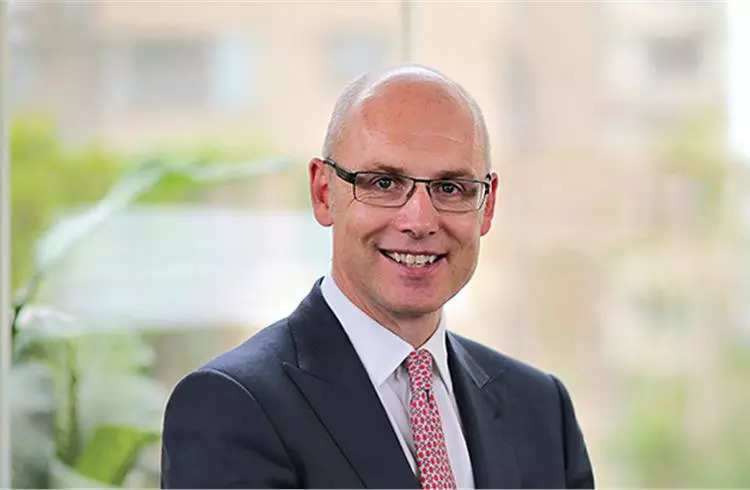
Warren Kevin Harris, CEO & MD, Tata Technologies, says “we have new concept engineering capabilities, we have mechanical capabilities but we also have software and embedded capabilities that are a match to anybody in the Indian engineering service provider arena. The thing that differentiates us is our ability to be able to integrate those technology solutions with mechanical systems and position support for our customers in the context of delivering entire subsystems and work packages all the way through the delivery of a complete vehicle.”Your growth rate has been slower than your peers over the last two to three years, a), what is the reason for that and b), do you think that you will outpace them in the near future?
If you look at the numbers, two years ago, we grew the business by 48%. Last year, we grew the business by almost 25%. In the first six months of this year, we grew services by over 21%. So if you look at a comparison between ourselves and our peer group, our growth rates either meet or exceed competition. We have been pleased with the momentum that we have established and we are working hard to ensure that we sustain that.I also want to talk about your client mix. Right now, it is 35 to 65 with respect to Tata versus your rest of the external clients as well. Going forward, is there an ideal target mix that you can guide us for because it has its own pros and cons? What is the ideal target mix for you?
I am not going to put a number on it but we would expect to grow our business outside of the group at a faster rate than we will grow the business inside of the group. Now, Tata Motors and JLR are doing very, very well at the moment. So, we may see an uptick in the percentage contribution from those customers in the next couple of years but I think medium to long-term, you will see the trajectory continue that we have established over the last 10 years.The other thing naysayers are talking about is how Tata Tech is into vanilla body engineering, product development and testing kind of services, whereas the likes of KPIT Tech is more into embedded and digital solutions. What would be your response to that? Are you looking at moving up the value chain in terms of offerings as well then?
What I would say is that when you are entrusted to develop a complete electric vehicle, you have to have capabilities across the entire value chain. You know, that is not just mechanical systems, it is also software and embedded electronics. And from the perspective of the breadth and depth of our capabilities, we believe that in the automotive business, we are a match to any of our competitors. We have new concept engineering capabilities, we have mechanical capabilities but we also have software and embedded capabilities that are a match to anybody in the Indian engineering service provider arena. The thing that differentiates us is our ability to be able to integrate those technology solutions with mechanical systems and position support for our customers in the context of delivering entire subsystems and work packages all the way through the delivery of a complete vehicle. We think that that is a difference that matters to our customers and we will continue to build a moat around those capabilities.
Auto ER&D is a space which is seeing a lot of spend. Where would you say we are in the spend cycle right now? How long do you see it sustaining and are we nearing the peak at all?
I do not think we are anywhere near it. I think we certainly are driving disruption and change around the move to autonomous work, the move to connected services, the move to alternative propulsion systems and specifically electrification and the move to shared mobility. But I believe that we are right at the beginning of that journey. We have seen very progressive companies like Tesla and the new energy vehicle companies in China and the United States drive the type of change that everybody else is now looking to emulate. We are right at the beginning of that.
And as the clock speed of technology change continues to accelerate, what we expect is the customers that we are working with to look increasingly to the outside to get access to the skills that they are going to need. And that is going to provide significant tailwinds for our industry, for Tata Technologies and specifically for companies that are based in India. We believe in India’s demographic advantage; we believe that India’s heritage in terms of delivering professional services at scale truly differentiates the region and those companies in it.
You talked about Indian talent, but one of the ways the global companies are looking at tapping into that is by setting up their captive GCCs in India versus outsourcing that they do usually through you. Do you see that as a big threat that the companies will set up their own units rather than coming to you?
I certainly think that anybody that is going to be in the product development business will have to have a meaningful nexus in India. I do not think it is a choice anymore. But I think that companies like ourselves that have grown up in India understand what it takes to be successful in India particularly as it pertains to attracting and retaining the best talent. I believe we have an advantage that will be very difficult for GCCs and for foreign ESPs that want to come into India to invest. We are not complacent about the challenge or the threat that they represent, but we are certainly confident in the advantage that we represent.
Within aviation, can you also clarify about Boeing? Is that expected to be onboarded as a client and to your overall product mix? Will you be diversifying beyond aviation and transport?
Well, let me start with the question around our customer base in aerospace. We are bound by client confidentiality agreements and so I cannot be specific about the customers that we are working with, outside of those that have given us permission to talk publicly. But we are connected and involved with the largest and the most progressive players in aerospace. We believe that that business with those customers will continue to grow.
Although our business mix at the moment is kind of 90-10 with automotive obviously being the largest over the next three to five years, we would expect aerospace of a relatively small base to grow at a faster rate than what we are seeing in automotive. As far as interest outside of the three industry verticals that we are currently involved with, automotive aerospace and transport construction and heavy machinery and typically transport construction and heavy machinery lags automotive by three to four years. We are starting to see the same sort of demand around alternative propulsion systems and connected services there that we have seen in automotive.
Shifting focus to the IPO specifically, it is a complete OFS and you have a decent amount of cash lying on the books. What would you be using that cash for? Are you looking at some acquisitions or have you had the history of buybacks and sizable dividends and that likely to be the course of action in terms of capital allocation policy?
: That is a question that obviously the board will make a decision on, but you are absolutely right. We have a track record almost since the formation of the company for delivering value back to shareholders either through dividends or more recently we have done a couple of buybacks. I would expect that to continue. We have done acquisitions in the past where it makes sense. We will be open to that in the future where we can accelerate capability or when we have the opportunity to enter a new logo that we are attracted to will certainly be open to doing that inorganically.
We expect the business to be somewhat balanced in terms of the capital we put to work to grow the company and to build out our value proposition with the responsibility that we have, the continuous responsibility that we have to give back to shareholders when it is appropriate.
And given that margins are close to the industry average from here on, do you see levers like onshore, offshore, maybe automation for margin expansion or is it realistic to assume the current range that you have will be maintained?
I am never comfortable with our as-is condition. I always want to drive improvement and we think that as far as margins are concerned, there is incremental improvement through operating levers. We are at the moment 50-50 in terms of onshore, offshore revenues. We are not an India out company. We are a very balanced onshore, offshore company. We represent a global proposition and we think that there is the opportunity to grow our offshore contribution to 65-70%. We do not think we will ever get to sort of the 80-20, 90-10 positions because of the nature of our value proposition.
We are in the business of turnkey delivery of complete vehicles and when you are entrusted with the family jewels of a manufacturing company, you have to deal an interface with all of the various stakeholders, that requires proximity to our customers and we deliver that through our onshore teams and that is a great compliment to the work that we do in India and in Eastern Europe.

















